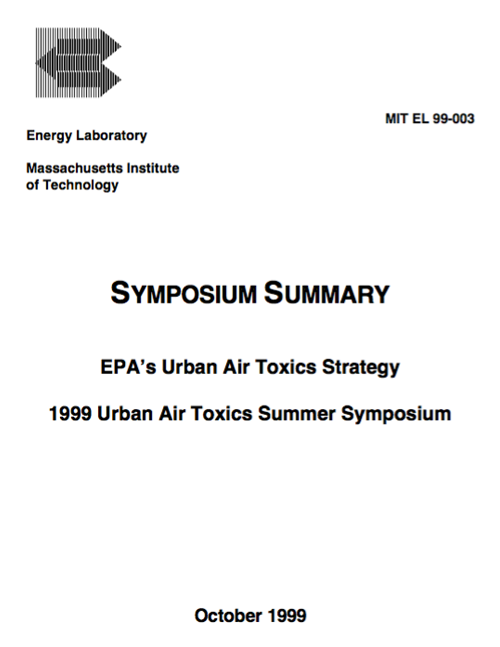
Symposium Summary: EPA’s Urban Air Toxics Strategy
1999 Urban Air Toxics Summer Symposium
Abstract
The Summer Air Symposium is a continuation of conferences established in 1993 for the purpose of informing decision makers on scientific aspects of important air pollution issues. Participation is limited to invited members of the scientific, regulatory, industrial, and public interest communities. The small size of the group promotes discussions that have led to important progress on ideas for improvements in air pollution control. The conference is co-sponsored by a variety of organizations (see Appendix I).
The objective of the 1999 Symposium was to discuss scientific aspects of EPAs Urban Air Toxics Strategy, including the influence of science on policy and the influence of policy on scientific research. Specific questions to be addressed include:
- What is known?
- What are the uncertainties and their magnitude?
- What research should be done?
The EPA Urban Air Toxics Strategy is a new type of undertaking because its a strategy, not a rule. It sets priorities and a schedule for ongoing action. The Clean Air Act Amendments of 1990 (CAAA) identify 189 pollutants as air toxics. The CAAA establish a two-step approach for regulating these pollutants: (1) standard setting, which is designed to get broad reductions across the board, along with incidental reductions from mobile source programs, and (2) determination of whether additional reductions are needed to protect health and the environment. The Urban Air Toxics Strategy, residual risk standards, and mobile source study and standards come under the second step. The biggest challenge is to regulate while were still learning: source inventories are evolving and our understanding of atmospheric transformation and cumulative effects is still incomplete. The paradigm is:
Sources present a complex challenge. There are multiple pollutants, multiple sources, and we only have primitive emission characterization. Many ambient pollutants result from transformation in the atmosphere. Monitoring has provided some ambient data showing some downward trends but by no means enough. We need a national system, but need to be careful not to overbuild, for resources might be better used elsewhere. There are a lot of existing data that could be analyzed. Data challenges include a lack of prescribed methods and a need to better understand variability. States need to participate in decisions concerning when and how to act.
Exposure is the connection between ambient concentrations and health effects. For toxics, there is a special need to understand indoor vs. outdoor sources and exposures. Indoor exposures are poorly understood. We need to develop source apportionment tools, and this is critical to developing cost- effective control strategies. The Cumulative Exposure Project is a major effort to address all sources, and it has come reasonably close to monitored levels. It is being brought into the Urban Air Toxics Strategy and updated (NATA). The challenges are dealing with a 1990 inventory, improving the quality of modeling, and public/risk communication. MATES II is an example of a very community-oriented attempt to do some of these same things.
Diesel and mercury are in some sense the easy cases. We understand the sources, have health data, and there is a history and technology of controlling emissions. With respect to diesel, the debate is whether its emissions constitute an air toxic or not, and how large the risk is (which can be addressed with quantitative risk assessment tools). There has been less debate today concerning what to do about it. Is it regulated as PM? As an air toxic? Resolving these issues is important for determining diesel control strategies. Mercury is a very public issue because of fish advisories and TRI data. We know the primary anthropogenic sources, and control is possible, although at a cost (catching a few fish in a big lake).
Health effects are a key element and a major challenge in developing an air toxics regulatory strategy. There is a miserably inadequate data set for quantitative risk assessment. Only 14 of 33 priority HAPs have potency values, and there are quantification challenges, as well as questions about mechanisms at high and low doses. Unanswered is whether we are aiming for an acceptable level of risk (e.g. 1 excess cancer in a million) or an acceptable level of control (e.g. MACT).
Finally, there are many research needs to support an overall strategy. Priorities include source characterization and inventory building, atmospheric transformation, improved monitoring techniques and standardization, exposure assessment for key indoor/outdoor toxics, and health science including biomarkers for exposure and dose-response information.